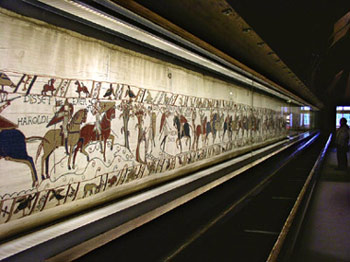After an early rise, our tour group made its first stop in Bayeux. As far as towns in Normandy go, there is nothing that stands out as remarkable at first sight. However, its fame comes from being the location of the incredible Bayeux Tapestry, a 70 metre (230 ft) long embroidered cloth illustrating the Norman conquest of England by William the Conqueror. The following synopsis is quoted from wikipedia.
The Bayeux Tapestry (French: Tapisserie de Bayeux, IPA: [tapisʁi də bajø], Norman : La telle du conquest) is an embroidered cloth—not an actual tapestry—nearly 70 metres (230 ft) long, which depicts the events leading up to the Norman conquest of England concerning William, Duke of Normandy and Harold, Earl of Wessex, later King of England, and culminating in the Battle of Hastings. The tapestry consists of some fifty scenes with Latin tituli (captions), embroidered on linen with coloured woollen yarns. It is likely that it was commissioned by Bishop Odo, William’s half-brother, and made in England—not Bayeux—in the 1070s. In 1729 the hanging was rediscovered by scholars at a time when it was being displayed annually in Bayeux Cathedral. The tapestry is now exhibited at Musée de la Tapisserie de Bayeux in Bayeux, Normandy, France.
The tapestry is on permanent display inside the Musée de la Tapisseri, however, cameras were not permitted. Fine by me, since photographing a 70 meter long cloth behind glass in low light would have been insane and pointless. So, I offer you the some Bayeux Tapestry images sourced from the internet.
The entire Bayeux Tapestry. Individual images of each scene are at Bayeux Tapestry tituli.



![120905-09-03-PENTAX K-5-smc PENTAX-DA- 16-50mm F2.8 ED AL [IF] SDM](http://www.robfaucher.com/wp-content/uploads/2012/09/120905-09-03-PENTAX-K-5-smc-PENTAX-DA-16-50mm-F2.8-ED-AL-IF-SDM.jpg)
![120905-09-04-PENTAX K-5-smc PENTAX-DA- 16-50mm F2.8 ED AL [IF] SDM](http://www.robfaucher.com/wp-content/uploads/2012/09/120905-09-04-PENTAX-K-5-smc-PENTAX-DA-16-50mm-F2.8-ED-AL-IF-SDM1.jpg)


